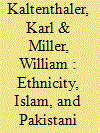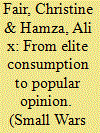| Srl | Item |
| 1 |
ID:
141295


|
|
|
|
|
| Summary/Abstract |
This article argues that an Islamist militant group with a relatively homogenous ethnic make-up is more likely to be supported by those of the same ethnicity even if the group makes no reference to and even downplays the importance of ethnicity. Using survey data from an original survey carried out in Pakistan in 2013, with 7,656 respondents, this hypothesis is tested in a multiple regression analysis of support for the Pakistani Taliban. The results demonstrate that co-ethnicity between the respondent and the Islamist militant group is the most important predictor of support for the militant group.
|
|
|
|
|
|
|
|
|
|
|
|
|
|
|
|
| 2 |
ID:
146226


|
|
|
|
|
| Summary/Abstract |
The United States has conducted armed drone strikes in Pakistan since 2004. While there has been some recent work on Pakistani public opinion about drones, there is very little research on how Pakistan’s media characterize the US drone program. This is an important gap in understanding the determinants of Pakistani popular perceptions of this program. Decades of research has shown that “news framing”, a process by which certain aspects of a complex concept are emphasized in political communications with others played down, influences individual cognition while forming political opinions. In this essay, we address this lacuna by assembling an unprecedented sample of editorials about the drone program from three English newspapers and one Urdu newspaper and analyzing the news frames within them. We next compare the trends in these news frames to public opinion data collected by Pew between the spring of 2009 and 2014. Initially, most Pakistanis were unaware of the drone program, media coverage of the program expanded as drone strikes increased in frequency. While Pakistanis became more cognizant of the US drone strikes, even by 2014 large minorities remained unaware. Pakistani public opinion strongly reflected the top media frames, particularly those that are negative. This is an important finding suggesting that newspaper editorials are a good barometer of Pakistani opinions despite the fact that only information elites rely upon newspapers for political information.
|
|
|
|
|
|
|
|
|
|
|
|
|
|
|
|